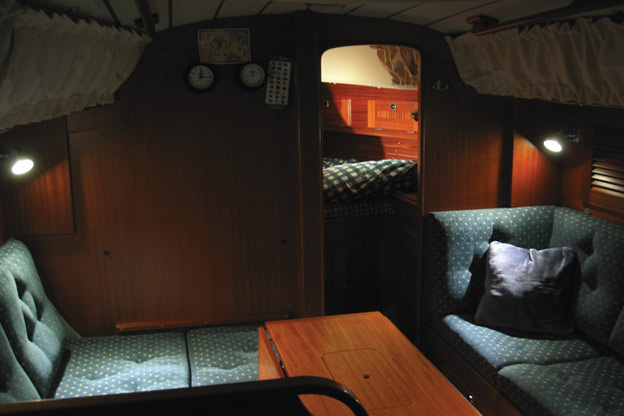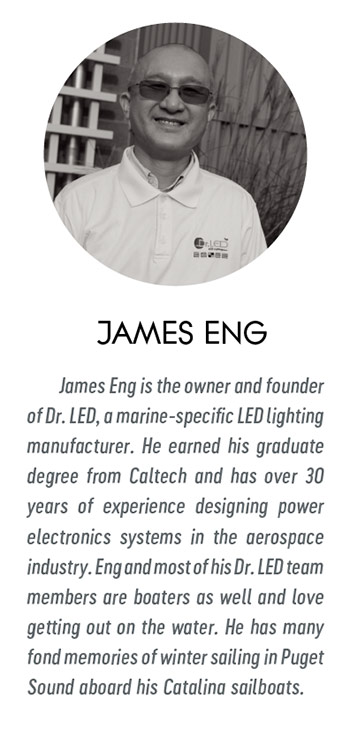 “It is better to light a candle than curse the darkness.”
“It is better to light a candle than curse the darkness.”
-Eleanor Roosevelt
You may have noticed the Christmas light displays popping up this time of year. We sure have, and, because we are Northwest Yachting, our thought processes shifted to lighting on our boats. Marine lighting is important after all, especially after the sun sets in Puget Sound where cargo ships and deadheads can be plentiful.
Marine lighting is a surprisingly complex subject, and the industry is still rocked by the LED revolution that began in the early 2000s. Long story short, just about everyone who can convert from Edison’s incandescent bulbs to LEDs are doing so, and the list for resisting is becoming shorter by the day. LEDs can even mimic the warm-glow look of incandescent, and with far longer life spans and less power demands per lumen, LED is winning the war. In all likelihood, it has probably already won.
But what makes a LED bulb better than the next? The market is flooded with cheap Chinese LED strips that are sold for pocket change. What do the maritime pros, like the Coast Guard or Navy, use? We scouted the Pacific Northwest for lighting gurus and found our expert for this edition of Ask the Experts. James Eng, owner and founder of Dr. LED, enlightens us to the world of marine lighting in late 2016.
Q: Tell us a little about yourself. Who are you and what is the story about Dr. LED?
Well, I was in aerospace since the mid 80s in the area and I’ve been designing electronics for a long time. I did my graduate work in power electronics at CalTech. I’ve been a boater since I was very young and most of our team members are boaters, mostly sailboat people.
About 15 years ago I recognized that LED was the way to go. The ratio of lumens (unit of light) per watt (unit of power) was increasing. The price was still expensive, but at the same time, it was dropping. We realized that soon it would replace the incandescent bulb.
Q: Yes, there seems to be quite a LED revolution since then in the marine world.
Yes. We started designing LED bulbs for the marine market in early 2000. Our first product line was LED replacement bulbs for navigation lights. At that time, it was the infancy of LED lighting in the marine market, so people didn’t know much about how to design and manufacture LEDs. 2004ish was really the birth of Dr. LED (with navigation bulbs).
Q: Let’s talk about the advantages that LED has over incandescent. What are they?
 Light Emitting Diode (LED) is a solid-state device that emits light when power is applied to it. It is rugged, lasts much longer, and is much more efficient than incandescent. LED bulbs will last much longer than incandescent provided they are properly designed and manufactured. For example, current regulation is a must in all LEDs and heat needs to be properly dissipated. By the way, all our products are fully tested at the factory for several hours.
Light Emitting Diode (LED) is a solid-state device that emits light when power is applied to it. It is rugged, lasts much longer, and is much more efficient than incandescent. LED bulbs will last much longer than incandescent provided they are properly designed and manufactured. For example, current regulation is a must in all LEDs and heat needs to be properly dissipated. By the way, all our products are fully tested at the factory for several hours.
Incandescent is about 10 lumens per watt. Also, incandescents, depending on the bulb, are rated from low 50 hours to 500 hours. With LED, they go to 10,000 hours easy if you design them to operate within their safe operating region.
Q: What are some of the challenges related to making LED bulbs? How complicated can it be?
In order to be in compliance with the U.S. Coast Guard and ABYC regulations for navigational lights, you have to meet a (chromaticity) spectrum and intensity requirements for what white or red or green is as specified. We have been the only one in the boating market offering a series of navigation LED bulbs that are in compliance with the US Coast Guard and ABYC regulations with certain navigation lights.
One thing many people don’t realize is that you can’t put a white LED bulb behind a color lens. It is kind of anti-intuitive. With incandescent, you put a white bulb behind a colored lens and you get that color (eg. green lens = green light), but you need to use a much higher wattage. For example, for a two-nautical mile anchor light,
you use a 10-watt incandescent bulb for white. But for a red or green lens, you need to use a 25-watt bulb. This is because you are not using most of the spectrum (energy) from the incandescent bulb. Hence, incandescent bulbs are very energy inefficient.
Meanwhile, LED is the other way around. It is very efficient when in color, but white LED is actually mostly blue and yellow. This is a human-eye response thing. We perceive white LED light as white, but if you look at the spectrum, it’s mostly blue and yellow. So if you put a white LED behind a red or green lens, it doesn’t look right. You don’t have the intensity and the color doesn’t respond as you think it would.
So we’ve been trying to educate boaters over last ten years that you need to keep this in mind. We design single color, bicolor, and tricolor LED bulbs for navigation lights and it is actually quite a challenge. We have several U.S. patents issued for us for our inventions. By the way, we were the first ones to come up with warm-white LEDs for interior lights.
Q: For the marine market?
Yes, in the marine market. About ten years ago, we came up with a series of warm white LED bulbs and fixtures for interior lights. The key was to make bulbs with the proper color temperature (whiteness measured in Kelvin). Most people like their “yellowish” (~2800 Kelvin) incandescent bulb for interior use. We came out with warn white LED bulbs at about 3,200 Kelvin. At the time, most were over 5,000 Kelvin which is rather bluish, cool white light. Since then, our warmest bulbs are getting warmer and warmer. Now they are below 3,000 Kelvin for a warmer glow.
Q: I’ve heard that the Navy, Coast Guard, and Air Force use your products? Those are some convincing endorsements.
We were the only one who put regulators inside the bulbs and fixtures when marine LED lighting was at its infancy. Most other brands of LED bulbs and fixtures had no regulation inside the fixtures or bulbs at that time. That was problematic, such LEDs would fail prematurely. For a 12-Volt system, the output voltage range varies from 11.5-Volt (discharged battery) to 14.5-Volt (battery being charged). Without regulation, LED bulbs would either be too dim at low voltage or burnt out at high voltage.
So when we first came out with our LED light bulb, we were the only ones with built-in regulation. Now it’s getting even more sophisticated with things like temperature compensation etc. And the bulbs last a lot longer.
The Navy was looking for LED fixtures for some of their vessels and after testing many brands of LED lights they decided to specify our fixtures. The U.S. Air Force also uses some of our fixtures in their boats as well. Some of our LED fixtures have U.S. Federal Government National Stock Numbers, meaning they are standardized government material items. The USCG buys some LED bulbs for their navigation lights for their cutters as they do not want to change the incandescent bulbs while underway at sea. One of the reasons was that we were among the first in the marine market to use U.S.-made CREE LEDs (the component) for our bulbs and fixtures. They have the best LEDs in the world.